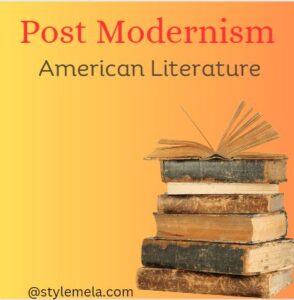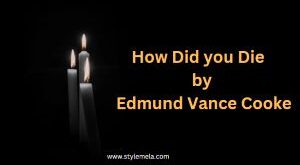What is Post Modernism in Literature?
Post Modernism American Literature
Post Modernism American Literature emerged as a response to the cultural, social, and political upheavals of the mid-20th century. American postmodernist writers experimented with narrative techniques, challenged traditional literary forms, and critiqued the dominant ideologies of their time. Here are some key aspects of postmodern American literature:
- Fragmentation and Nonlinearity: Postmodern American literature often features fragmented narratives and nonlinear storytelling. Writers such as Thomas Pynchon in “Gravity’s Rainbow” and Kurt Vonnegut in “Slaughterhouse-Five” employ non-linear structures to reflect the chaotic and disjointed nature of contemporary life.
- Metafiction: American postmodernist authors frequently employ metafictional techniques, blurring the boundaries between fiction and reality. For example, in John Barth’s “Lost in the Funhouse,” the author openly acknowledges the constructed nature of the narrative, inviting readers to question the act of storytelling itself.
- Pop Culture and Mass Media: Postmodern American literature often incorporates elements of popular culture and mass media. Writers like Don DeLillo in “White Noise” and Thomas Pynchon in “The Crying of Lot 49” explore the influence of consumerism, media saturation, and technology on contemporary society.
- Irony and Parody: Irony and parody are common features of postmodern American literature. Writers such as David Foster Wallace in “Infinite Jest” and Chuck Palahniuk in “Fight Club” use irony and satire to critique aspects of American culture, from consumerism to masculinity.
- Historical Revisionism: Postmodernist writers often engage in historical revisionism, challenging established narratives of history and identity. Toni Morrison’s “Beloved” reimagines the history of slavery, while Thomas Pynchon’s “Mason & Dixon” offers a revisionist take on the American colonial period.
- Identity and Marginalization: Postmodern American literature explores themes of identity, marginalization, and power dynamics. Writers such as Toni Morrison, Ralph Ellison, and Sandra Cisneros examine issues of race, gender, and class in works like “The Bluest Eye,” “Invisible Man,” and “The House on Mango Street.”
- Globalization and Postcolonialism: Postmodern American literature often engages with issues of globalization and postcolonialism. Authors like Jhumpa Lahiri in “The Namesake” and Junot Díaz in “The Brief Wondrous Life of Oscar Wao” explore themes of cultural displacement, hybridity, and diaspora.
Postmodern Literature Characteristics
Postmodern literature is characterized by several distinct features that set it apart from earlier literary movements. These characteristics reflect the broader cultural and philosophical shifts that occurred in the latter half of the 20th century. Here are some key traits of postmodern literature:
- Fragmentation and Discontinuity: Postmodern literature often features fragmented narratives, disjointed structures, and nonlinear storytelling. Authors may present their narratives in a non-chronological order or through multiple perspectives, reflecting the fragmented nature of modern experience.
- Metafiction and Self-Reflexivity: Postmodern writers frequently employ metafictional techniques, blurring the boundaries between fiction and reality. They may draw attention to the act of storytelling itself, incorporating elements such as footnotes, authorial intrusions, and intertextual references.
- Intertextuality and Pastiche: Postmodern literature embraces intertextuality, the practice of referencing and incorporating elements from other texts, genres, and cultural sources. Authors may borrow characters, themes, or styles from previous works, creating a sense of pastiche or collage.
- Irony and Playfulness: Irony, humor, and playfulness are common features of postmodern literature. Authors may use irony to subvert traditional narrative conventions, challenge reader expectations, or critique societal norms and values.
- Distrust of Grand Narratives: Postmodernism is characterized by a skepticism towards grand narratives or overarching truths. Instead, it embraces plurality, ambiguity, and relativism, acknowledging the existence of multiple perspectives and interpretations.
- Cultural Critique and Political Engagement: Postmodern literature often engages in a critical examination of contemporary culture, society, politics, and language. Authors may explore themes such as consumerism, globalization, identity, power dynamics, and the limitations of language.
- Experimentalism and Innovation: Postmodern writers are known for their experimental approach to form, language, and storytelling techniques. They may challenge traditional literary conventions and push the boundaries of what is considered “literature,” incorporating multimedia elements, nonlinear structures, and unconventional narrative techniques.
- Multiplicity of Voices and Identities: Postmodern literature reflects the diverse voices and identities of the modern world. Authors may depict characters from marginalized or underrepresented groups, exploring issues of race, gender, sexuality, and identity.
Overall, Post Modernism American Literature reflects the complexities and uncertainties of the contemporary world while inviting readers to question their assumptions and interpretations.
Themes and Techniques of Postmodern Literature
Postmodern literature encompasses a wide range of themes and techniques, reflecting the diverse perspectives and interests of its authors. Here are some common themes and techniques found in postmodern literature:
Themes:
- Metafiction and Self-Referentiality: Postmodern literature often explores the nature of storytelling itself, blurring the boundaries between fiction and reality. Authors may incorporate metafictional elements such as self-referential narration, authorial intrusions, and commentary on the act of writing.
- Fragmentation and Nonlinearity: Postmodern texts frequently feature fragmented narratives, disjointed structures, and nonlinear storytelling. This fragmentation mirrors the complexity and chaos of modern life, challenging traditional notions of coherence and continuity.
- Intertextuality and Pastiche: Postmodern literature embraces intertextuality, the practice of referencing and incorporating elements from other texts, genres, and cultural sources. Authors may borrow characters, themes, or styles from previous works, creating a sense of pastiche or collage.
- Irony and Parody: Irony, humor, and parody are common features of postmodern literature. Authors may use irony to subvert traditional narrative conventions, challenge reader expectations, or critique societal norms and values.
- Distrust of Grand Narratives: Postmodernism is characterized by a skepticism towards grand narratives or overarching truths. Instead, it embraces plurality, ambiguity, and relativism, acknowledging the existence of multiple perspectives and interpretations.
- Cultural Critique and Political Engagement: Postmodern literature often engages in a critical examination of contemporary culture, society, politics, and language. Authors may explore themes such as consumerism, globalization, identity, power dynamics, and the limitations of language.
- Identity and Marginalization: Postmodern literature reflects the diverse voices and identities of the modern world. Authors may depict characters from marginalized or underrepresented groups, exploring issues of race, gender, sexuality, and identity.
Techniques:
- Stream-of-Consciousness: Postmodern authors may use stream-of-consciousness techniques to represent the flow of thoughts and perceptions in their characters’ minds, blurring the boundaries between inner and outer reality.
- Multiple Perspectives: Postmodern texts often present multiple perspectives or points of view, challenging the notion of a single, objective truth. Authors may use shifting narrative voices, unreliable narrators, or fragmented storytelling to convey the complexity of human experience.
- Collage and Montage: Postmodern literature sometimes employs collage or montage techniques, assembling disparate elements into a cohesive whole. Authors may juxtapose different styles, genres, or media to create new meanings or associations.
- Hyperreality and Simulation: Postmodern authors may explore the concept of hyperreality, where reality and simulation become indistinguishable. They may depict a world saturated with media images, consumer products, and simulations of reality, blurring the boundaries between the real and the simulated.
- Play with Language and Form: Postmodern literature often experiments with language and form, pushing the boundaries of traditional literary conventions. Authors may use wordplay, puns, neologisms, and unconventional grammar to create innovative and challenging texts.
- Deconstruction: Drawing on the ideas of philosopher Jacques Derrida, postmodern literature may engage in deconstruction, dismantling binary oppositions and questioning hierarchical structures of meaning. Authors may challenge conventional interpretations and disrupt established norms through linguistic and textual strategies.
- Meta-narratives and Cultural Commentary: Postmodern literature may incorporate meta-narratives and cultural commentary, reflecting on the role of literature in society and the ways in which stories shape our understanding of the world. Authors may critique dominant ideologies, challenge literary canons, or reflect on the limitations of language and representation.
writers of Post Modernism American Literature uses these wide range of themes and techniques in their writings. Postmodern Literature reflects the complexities and uncertainties of the modern world while inviting readers to question their assumptions and interpretations.
Postmodern writers in English Literature
Postmodernism in English literature has seen the rise of several influential writers who have contributed significantly to the movement. Here are some notable postmodern writers in English literature:
- Samuel Beckett: An Irish playwright, novelist, and poet, Beckett is known for his absurdist and minimalist style. His works, such as “Waiting for Godot” and “Endgame,” often explore themes of existentialism, human consciousness, and the search for meaning in a seemingly meaningless world.
- Kurt Vonnegut: An American author, Vonnegut is known for his satirical and darkly humorous novels. Works like “Slaughterhouse-Five” and “Cat’s Cradle” blend science fiction, social commentary, and metafiction to explore themes of war, free will, and the human condition.
- Thomas Pynchon: An American novelist, Pynchon is celebrated for his complex and sprawling narratives that often feature elements of paranoia, conspiracy, and postmodern pastiche. His notable works include “Gravity’s Rainbow,” “The Crying of Lot 49,” and “Mason & Dixon.”
- Don DeLillo: Another prominent American novelist, DeLillo’s works often explore themes of consumerism, media saturation, and the disintegration of the American Dream. His notable novels include “White Noise,” “Underworld,” and “Libra.”
- Angela Carter: A British author known for her feminist reimaginings of fairy tales and folklore, Carter’s works often challenge traditional gender roles and societal norms. Her notable works include “The Bloody Chamber,” “Nights at the Circus,” and “Wise Children.”
- Margaret Atwood: A Canadian author renowned for her dystopian and speculative fiction, Atwood’s works often explore themes of power, gender, and environmental degradation. Her notable novels include “The Handmaid’s Tale,” “Oryx and Crake,” and “Alias Grace.”
- David Foster Wallace: An American writer known for his ambitious and innovative fiction, Wallace’s works often employ metafictional techniques, footnotes, and stream-of-consciousness narration. His notable works include “Infinite Jest,” “The Broom of the System,” and “Brief Interviews with Hideous Men.”
- Jeanette Winterson: A British author known for her lyrical prose and exploration of themes such as love, identity, and storytelling. Her notable works include “Oranges Are Not the Only Fruit,” “Written on the Body,” and “The Passion.”
- Salman Rushdie: An Indian-British author known for his magical realism and postcolonial themes. His notable works include “Midnight’s Children,” “The Satanic Verses,” and “The Moor’s Last Sigh.”
- Italo Calvino: He was an Italian novelist and short story writer known for his imaginative and experimental approach to literature. His works often blend elements of fantasy, science fiction, and metafiction, reflecting his fascination with storytelling and the creative process. One of his most famous works is “If on a winter’s night a traveler” (1979), a novel that explores the act of reading itself.
These writers, among others, have played a significant role in shaping postmodern literature in English, challenging conventional narrative forms, exploring existential questions, and engaging with the complexities of contemporary society.
Read More:

